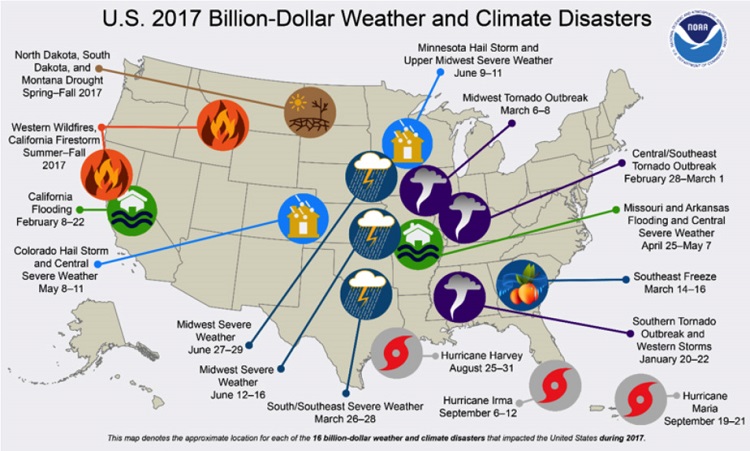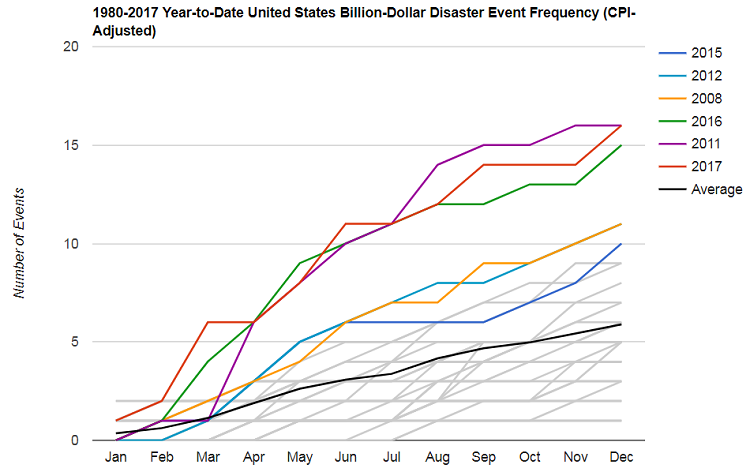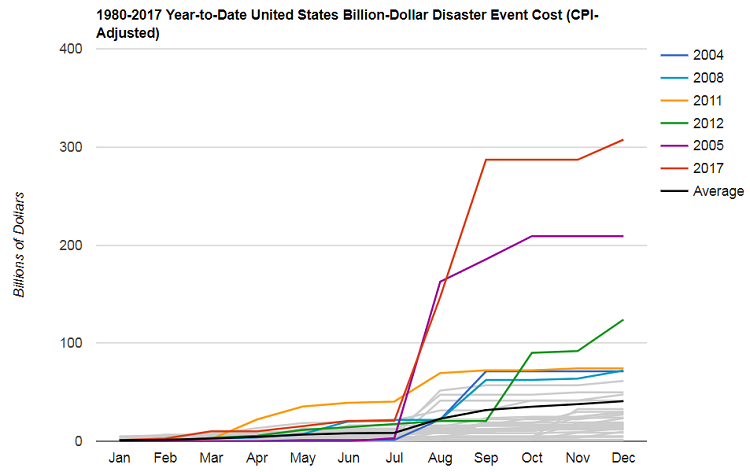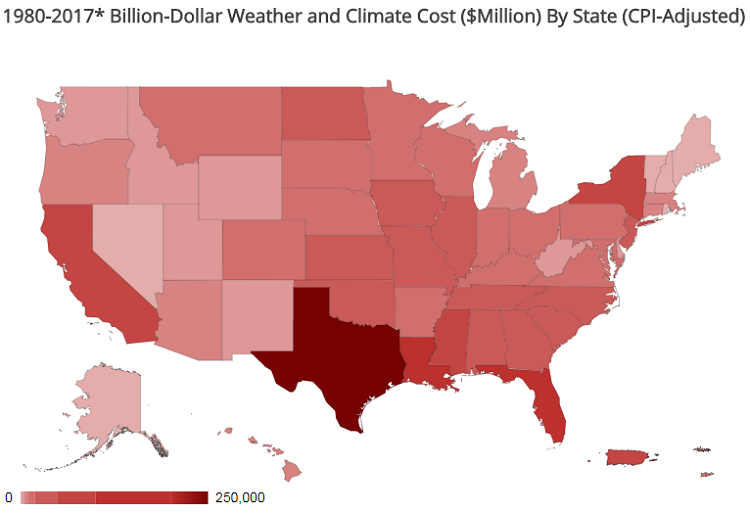Record Year: Sixteen Billion-Dollar Weather Disasters
During 2017, the U.S. was impacted by 16 separate billion-dollar disaster events including: three tropical cyclones, eight severe storms, two inland floods, a crop freeze, drought and wildfire.
NOAA’s National Centers for Environmental Information says 2017 ties with 2011 for the highest number of billion-dollar disasters for a single year. Since 1980, the U.S. has sustained 219 weather and climate disasters where the overall damage costs reached or exceeded $1 billion (including adjustments based on the Consumer Price Index, as of December 2017). The cumulative costs for these 219 events exceed $1.5 trillion.

A map depicting the general locations of the 16 billion dollar weather and climate disasters of 2017.

This graphic shows the month-by-month accumulation of billion dollar disasters for each year on record. The value for a given year for a given month shows the total number of billion-dollar events that had occurred by that month. Note that there is considerable overlap, and some years' traces are obscured.
Perhaps more notable than the high frequency of these events is the cumulative cost, which exceeds $300 billion in 2017 - a new U.S. annual record. The cumulative damage of these events is $306.2 billion, which shattered the previous U.S. annual record cost of $214.8 billion (CPI-adjusted) in 2005 due to the impacts of Hurricanes Dennis, Katrina, Rita and Wilma.
The damage from Hurricanes Harvey, Irma and Maria alone are responsible for approximately $265 billion of the $306.2 billion. Each of these destructive hurricanes now joins Katrina and Sandy, in the new top five costliest U.S. hurricanes on record.

This graphic depicts the accumulation in the estimated cost of billion dollar weather and climate disasters on a monthly basis, for each year since 1980.
Hurricane Harvey
In late-August, Hurricane Harvey caused unprecedented amounts of rainfall (up to 60 inches) over Houston, one of America's largest cities. Harvey was a category 4 hurricane making landfall near Rockport, Texas and causing widespread damage. More than 30 inches of rainfall fell on 6.9 million people, while 1.25 million experienced over 45 inches and 11,000 had over 50 inches, based on seven-day rainfall totals ending August 31. This historic U.S. rainfall caused massive flooding that displaced over 30,000 people and damaged or destroyed over 200,000 homes and businesses. The costs for Harvey are approximately $125 billion, only second to Hurricane Katrina ($160 billion, after inflation adjustment to 2017 dollars).
Hurricane Irma
In early September, Hurricane Irma devastated the Florida Keys with its high winds and storm surge, after flattening the U.S. Virgin Islands - St John and St Thomas - among other Caribbean islands. Irma was another category 4 hurricane when it made landfall at Cudjoe Key, Florida, after devastating the U.S. Virgin Islands - St John and St Thomas - as a category 5 storm. The Florida Keys were heavily impacted, as 25 percent of buildings were destroyed while 65 percent were significantly damaged. Severe wind and storm surge damage also occurred along the coasts of Florida and South Carolina. Jacksonville and Charleston received near-historic levels of storm surge causing significant coastal flooding. Irma maintained a maximum sustained wind of 185 mph for 37 hours, the longest in the satellite era. Irma also was a category 5 storm for longer than all other Atlantic hurricanes except Ivan in 2004. The costs for Irma are approximately $50 billion, which excludes additional severe damage to non-U.S. territories.
Hurricane Maria
In mid-September, Hurricane Maria barreled through the southern Caribbean on a path toward Puerto Rico. Maria was comparable to Irma in its maximum wind damage, but also similar to Harvey in the feet of rain it dumped across Puerto Rico. Maria made landfall in southeastern Puerto Rico as a category 4 hurricane, after striking the U.S. Virgin Island of St. Croix. Maria's extreme winds caused widespread devastation to Puerto Rico's transportation, agriculture, communication and energy infrastructure. This damage was made more severe by the tremendous rainfall up to 37 inches, which caused widespread flooding and mudslides across the island.
The interruption to commerce and standard living conditions will be the case for years, as much of Puerto Rico's infrastructure has to be entirely rebuilt. Maria tied Hurricane Wilma (2005) for the most rapid intensification, strengthening from tropical depression to a category 5 storm in 54 hours. Maria's landfall at Category 4 strength gives the U.S. a record three Category 4+ landfalls this year (Maria, Harvey, and Irma). The costs for Maria are approximately $90 billion.
The bigger picture
The years 2017 and 2016 each had a historically high number of billion-dollar disasters that impacted the U.S. (16 and 15 events, respectively). 2016 and 2017 also each had U.S. hurricane impacts exceeding $10 billion; hurricanes are historically the most damaging and costly weather events to affect the U.S.
The U.S. has experienced a rising number of events that cause significant amounts of damage. From 1980–2016, the annual average number of billion-dollar events is 5.8 (CPI-adjusted). For the most recent five years (2013–2017), the annual average is 11.6 events (CPI-adjusted).
Climate change is also paying an increasing role in the increasing frequency of some types of extreme weather that lead to billion-dollar disasters. Most notably the rise in vulnerability to drought, lengthening wildfire seasons and the potential for extremely heavy rainfall and inland flooding events are most acutely related to the influence of climate change.

This map depicts the total estimated cost borne by each state, from billion dollar weather and climate events.
